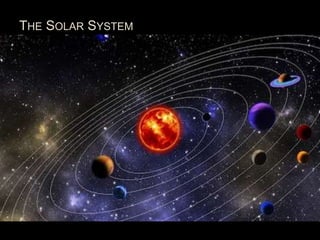
Introduction to SOLAR SYSTEM_Grade 6 Lesson.pptx
- 1. THE SOLAR SYSTEM *Picture of solar system
- 2. Orbit – imaginary path where the planets travels around the sun Prominent – outstanding; famous Solar – has something to do with the Sun Satellite – moon; smaller object orbiting around a planet
- 3. ACTIVITY LIFT-OFF! Form into 4 groups. Choose your Leader and Assistant Leader. Get the activity sheets and materials for your group. NOTE: Group will present their outputs to the class after each activities. GOOD LUCK!!!
- 4. ACTIVITY 1: WATCH AND LEARN The SOLAR SYSTEM
- 5. ACTIVITY 2: ARRANGE ME Based on the video you watched, arrange the heavenly bodies found in the Solar System according to their orbit/location Draw circles on the Figure 1 to represent the heavenly bodies. Label each heavenly bodies. Complete task in 5 minutes.
- 7. QUESTIONS: What heavenly body is found at the center of the Solar System? What are the planets in the Solar System (from the nearest to the farthest from the Sun)?
- 8. ACTIVITY 3: FILL ME UP Study the table. (Table 1) Fill up the cells with information needed. (Characteristic could be about their color, size, distance from the sun, temperature, or other features) Complete task in 5 minutes.
- 9. TABLE 1: PLANETS PROMINENT CHARACTERISTICS Mercury can be very cold and very hot
- 10. TABLE 1: PLANETS CHARACTERISTICS Mercury nearest to the sun, smallest planet Venus hottest planet, fire planet Earth water planet, only known planet to support life Mars red planet, believed to have harbored life before Jupiter Gas giant, largest planet Saturn Gas giant, has magnificent ring system Uranus Ice giant, coldest planet Neptune Ice giant, farthest planet
- 11. QUESTIONS: Why is Pluto not considered as one of the major planets? Why is it important to study about the planets?
- 12. Directions: Read the statements in the first column carefully. Write “TRUTH” if the statement is correct otherwise, write “BLUFF, on the second column. Then support your answer by writing your explanation in the third column. Note: Complete task in 5 minutes. Statement True/False Explanation 1. Sun is the center of the Solar System 2. The solar system is made up of only the Sun and the eight planets. 3. Mars can support life. 4. Pluto is the most distant and last object in the Solar System. Activity 4: Misconception Check
- 13. TOUCHDOWN: 1. What are the different planets in the solar system? 2. What is the center of the solar system?
- 14. SPACE GRILL! CHOOSE THE LETTER OF THE CORRECT ANSWER. 1. How many planets are there in the solar system? A.8 B. 9 C. 10 D. 4 2.Name the planet found between Mars and Saturn. A. Neptune B. Jupiter C. Uranus D. Earth 3. Which statement about the solar system is correct? A. The planets orbit the sun. B. The sun orbit the planets C. Satellite orbit asteroids D. The planet does not orbit all the time. 4. Which of these does not fit into either major category of a planets. A. Mercury B. Jupiter C. Pluto D. Earth 5.Which planet is the nearest to the sun A. Neptune B. Jupiter C. Uranus D. Mercury
- 15. 6. Why Mercury has the shortest period of revolution around the sun? A. Mercury is the nearest planet to the sun. B. Mercury is the smallest planet to the sun. C. Mercury move fast than the other planets. D. None of the above 7. What planets seems to be the largest? A. Neptune B. Jupiter C. Uranus D. Mercury 8. What is the center of the solar system A. Asteriod B. Pluto C. Neptune D. Sun 9.What ikind of heavenly body is the sun? A. Star B. Planet C. Moon D. Meteor 10. Why is the sun also considered a star? A. The sun has the same structure as a star. B. The sun emits heat and light just like a star. C. The sun has similar color with that of a star D. Both A and B.
- 17. Prepared by: JENIFER B. PECSON T-I Balantacan ES Lubao West District …